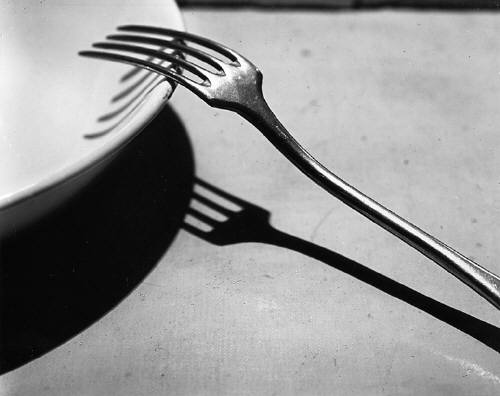Born in Budapest in July of 1894, Kertesz was one of three brothers from a middle-class family. Soon after getting his bachelor’s degree from the Hungarian Academy of Commerce in 1912, he found a job as a clerk at the Budapest Stock Exchange. Though the work seemed far from his deeper aspirations, it did provide him with the resources to purchase his first camera. When, in 1914, he was drafted into the Austro-Hungarian army, he brought along his camera. The photographs he made during the war represent the beginnings of his formation as a serious artist. Unlike other war photographs, Kertesz’s concerned themselves with the lives of soldiers away from the fighting. Part of Kertesz’s genius was his ability to cast attention on images seemingly “unimportant.” These subtle images of the moments of joy and contemplation away from the front were a revolutionary use of the newly invented hand-held camera. - Pbs.org
Though some of Kertesz' work was fairly ordinary and didn't leave much to the imagination, he did also do work which was not as easily analysed. He dabbled in photojournalism and is considered one of the great influences for photo journalists today. Kertesz had a 'distortion period' in which he experimented with the naked female form in the reflection of a carnival mirror that extruded their features. Though he is not as well known for his distortion period in 1933, he is more famous for his still life work; though in my opinion it was his least interesting of his work.
 |
| Distortion 65. http://www.higherpictures.com/ImageViewer.aspx?id=403 |
 |
| An example of his photo journalism work. https://blogger.googleusercontent.com/img/b/R29vZ2xl/AVvXsEhkfCBk-qtJLC9aSTspwJrT2wxzth-182IDwaaXyYa6Wp20qUyl9rnFZsPS-dYz0AQgvih9J0K2t8aFVjS5QPJTDc4knV88jTqg_1qDJH5hd8PbiyIZkb9HG7VsZlBFK2BBOkwLDby_Xpc/s1600/kertesz.jpg |
 |
| Fork. http://blog.ricecracker.net/wp-content/uploads/2009/09/Estate_of_Andre_Kertesz_Fork_Paris_1928_1019_55.jpg |
My analysis of an example of his work (Fork):
To refer back to a post I found online, an analysis of the picture, I believe that no further analysis can be made other than the photographic skill boxes that it ticks off. The post I read dumbfounded said:
An image that easily captures attention and stays long in memory. Maybe because we didn’t expect such a performance from the mundane and the taken for granted around us. Kertesz has masterly simplified here into an abstraction that take us by surprise. Maybe because we sense – reluctantly – that the fork hides so much about us. Things which reflect forms of social life and ways of individual self-discipline, entailed in the development of modern manners.
Reading this, in my personal opinion, I think that this photo is more glorified than it actually should be. This photo, I believe, is only good in the sense that it presents a good composition and the tones in the piece are strong and contrasty. This photo looks like something that you can imagine being seen hung on the walls of a coffee shop. I see nothing amazingly interesting in this picture. If this picture was done by a digital photographer in this day and age, it would be disregarded and not given any form of attention whatsoever. Perhaps people were interested by it because photographer had been a new art form when this photo was released and nothing of the sort had been seen before hand. I find his distortion work far more intriguing.
 |
| http://www.bulgergallery.com/dynamic/images/display/Estate_of_Andre_Kertesz_Distortion_63_Paris_1933c1980_3120_41.jpg |
When I first saw the distortion series by Kertesz, I immediately thought that as a man himself; Kertesz was looking at the female form in a more in depth perception. Men worship the female body, and I think that when doing this work he was trying to make the women's bodies look as lop sided and ugly as possible. Women are the ones that are on the front of Vogue Magazine, and are seen as the beautiful ones. I think in this set of photographs, Andre Kertesz was seeing an ugly side to the female physique that was perhaps underneath the clothes that men did not see. To refrain from sounding sexist at all costs, women are notorious for being controlling of men and all women know that they, in a sense, have a precedence over men because of the fact men are so in awe and confounded when faced with the naked female form. Looking more abstractly at the photographs, maybe it was being shown that underneath the clothes, the female body may be attractive to men in a siren form, it is an ugly sight when faced with something that can control men and make them helpless to only cater to the every whim that is asked of them, all if getting what's underneath the clothes is the end prize.

Your blog is now visual and well written, well done. You have posted on a regular basis and it shows. Keep it up.
ReplyDelete